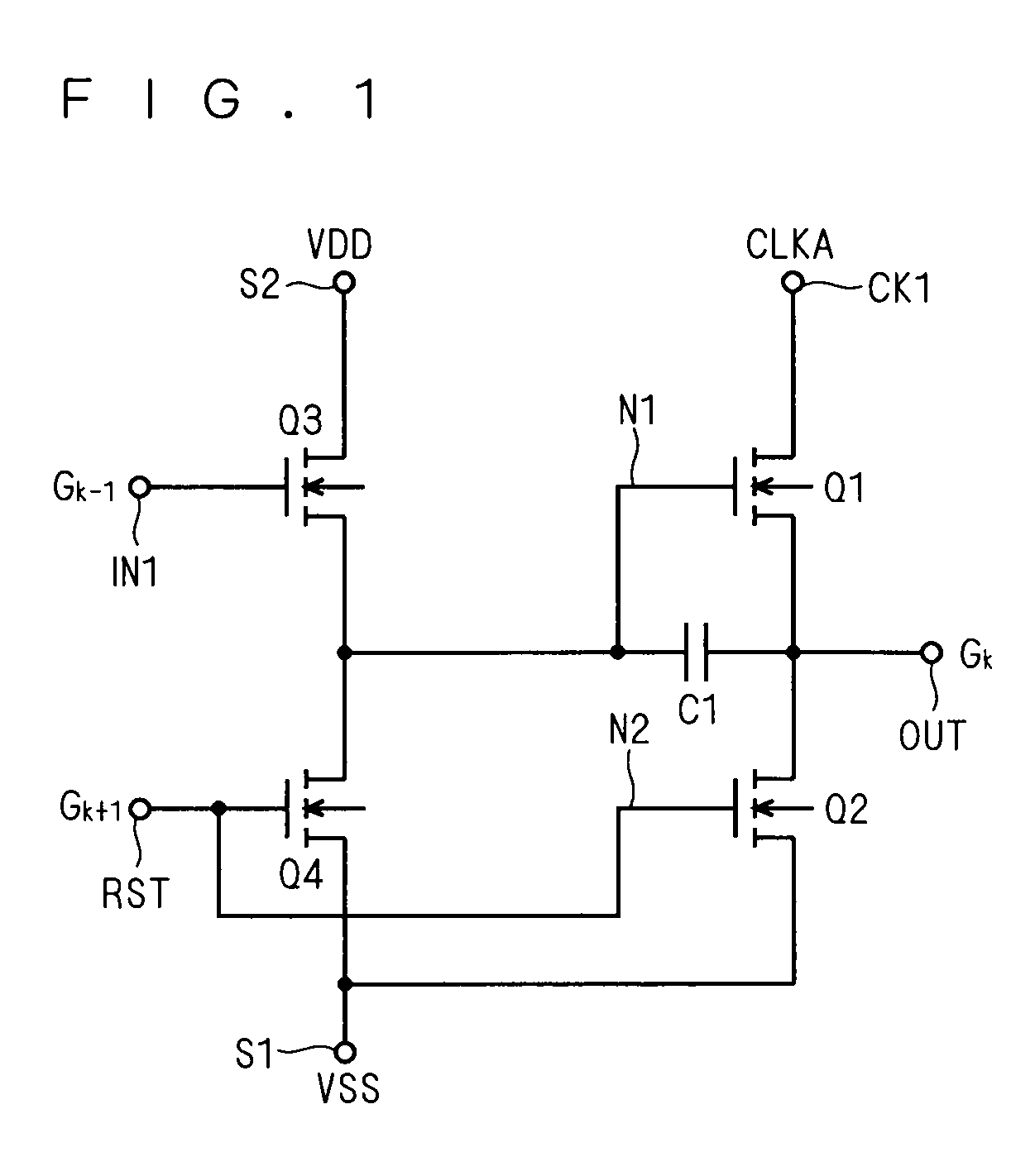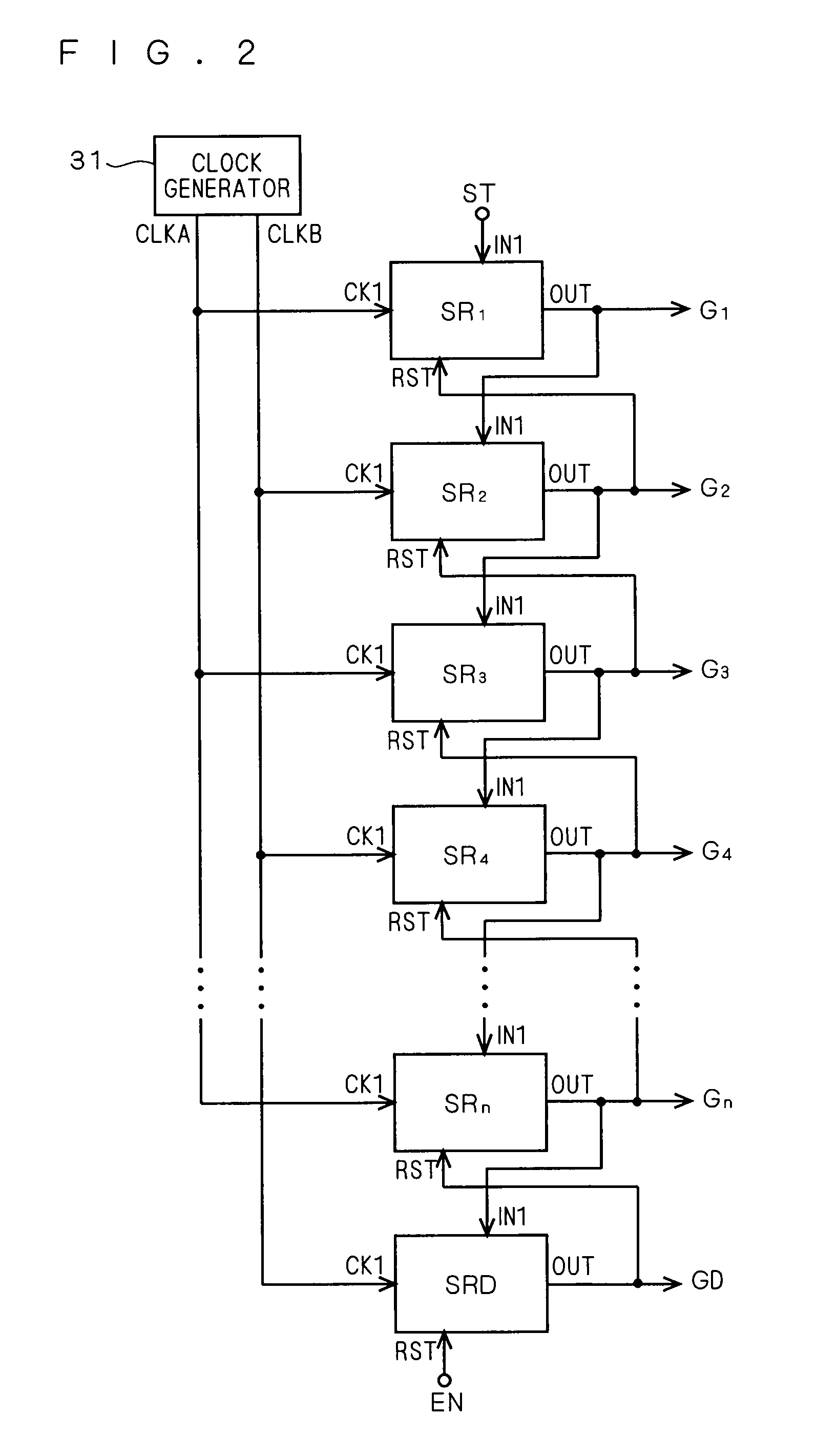Semiconductor device and shift register circuit
a technology of shift register and semiconductor device, which is applied in the direction of digital storage, pulse automatic control, instruments, etc., can solve the problems of circuit malfunction, similar vth shift problem in organic transistor, etc., and achieve the effect of preventing circuit malfunction of semiconductor devi
- Summary
- Abstract
- Description
- Claims
- Application Information
AI Technical Summary
Benefits of technology
Problems solved by technology
Method used
Image
Examples
first preferred embodiment
[0040]For ease of description of the present invention, a conventional shift register will be described first. Typically, the shift register has a multistage structure made up of a plurality of shift registers connected in cascade (cascade-connected). Throughout the present specification, each of the shift registers constituting the multistage shift register will be called “a unit shift register”.
[0041]As described earlier, the shift register can be used as a gate-line driving circuit of a display apparatus. A specific configuration of a display apparatus employing a shift register as the gate-line driving circuit is disclosed in, e.g., Japanese Patent Application Laid-Open No. 2006-277860 made by the inventors of the present application (FIGS. 1, 2, etc). The following description will be made assuming that the low supply voltage (VSS) as a reference potential of the circuit is 0V; in a practical display apparatus, however, a reference potential is determined with reference to a vo...
second preferred embodiment
[0090]A specific example of a shift register to which the dual-gate transistor according to the present invention may be applied will be described.
[0091]FIG. 11 is a circuit diagram of a unit shift register SR according to a second preferred embodiment. The unit shift register SR includes an inverter added to the circuit shown in FIG. 7, where the node N1 (gate of transistor Q1) serves as its input node and the node N2 (gate of transistor Q2) serves as its output node. That is, the gate of the transistor Q2 (node N2) is not connected to the reset terminal RST, unlike the circuit shown in FIG. 7.
[0092]The inverter is made up of a transistor Q5 diode-connected between the node N2 and second power terminal S2 and a transistor Q6 connected between the node N2 and first power terminal S1 having its gate connected to the node N1. The on-state resistance of the transistor Q6 is set sufficiently smaller than that of the transistor Q5.
[0093]Since the transistor Q6 turns off when the node N1 ...
third preferred embodiment
[0097]FIG. 12 is a circuit diagram of a unit shift register SR according to a third preferred embodiment. The unit shift register SR includes a transistor Q7 having its gate connected to the node N2 additionally provided between the node N1 and first power terminal S1 in the circuit shown in FIG. 11. That is, the transistor Q7 has a gate electrode connected to the node N2 and is intended to discharge the node N1.
[0098]In the unit shift register SRk shown in FIG. 11, the transistor Q4 turns on to discharge the node N1 when the output signal Gk+1 from the immediately succeeding stage rises to the H level (in the selected period of the succeeding stage), but the node N1 is at the L level with high impedance (floating state) in the other non-selected period. The node N1 therefore rises in level when supplied with charges by noise or leak current in the non-selected period. Then, the malfunction occurs in which the transistor Q1 turns on and output signal G is output as an error signal.
[...
PUM
 Login to View More
Login to View More Abstract
Description
Claims
Application Information
 Login to View More
Login to View More - R&D
- Intellectual Property
- Life Sciences
- Materials
- Tech Scout
- Unparalleled Data Quality
- Higher Quality Content
- 60% Fewer Hallucinations
Browse by: Latest US Patents, China's latest patents, Technical Efficacy Thesaurus, Application Domain, Technology Topic, Popular Technical Reports.
© 2025 PatSnap. All rights reserved.Legal|Privacy policy|Modern Slavery Act Transparency Statement|Sitemap|About US| Contact US: help@patsnap.com



